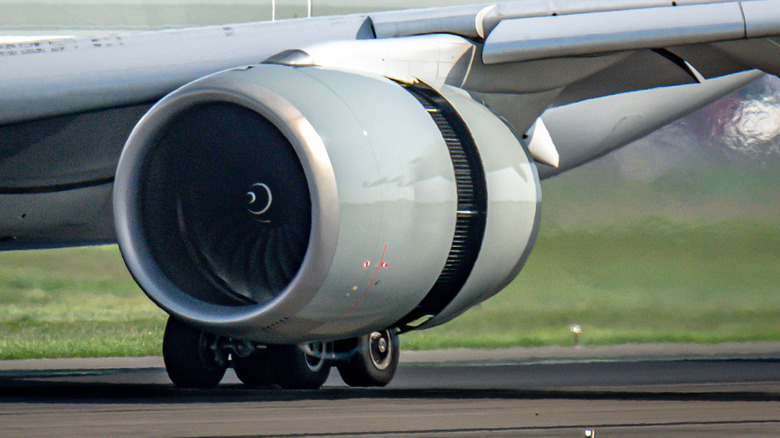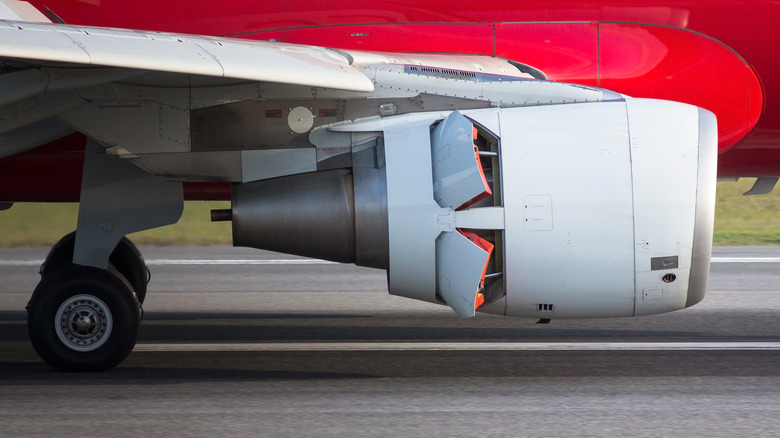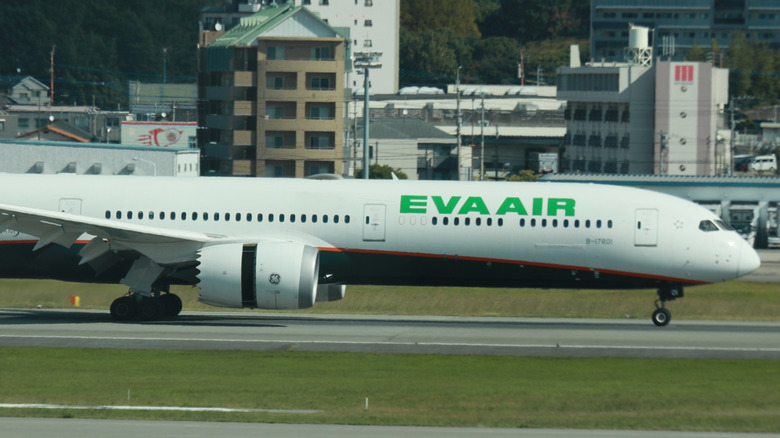Why Do Plane Engines Open When Landing?
Landing a massive passenger aircraft requires a host of different systems and procedures to work correctly, and there are many redundancies in place when conditions are less than ideal or the timetables are particularly tight. A typical airliner might have a landing weight exceeding some 60 tons, with all that force traveling down the runway at over 150 miles an hour at touchdown. How do you slow down something with that much momentum?
This reason is precisely why aircraft feature such large, specialized brakes. However, an airliner's brakes work much like a typical passenger car; they convert the kinetic energy of the plane moving forward into thermal energy. In effect, they're simply extraordinarily large car brakes, capable of arresting a speeding, fully-loaded aircraft at takeoff speeds in the case of a rejected takeoff (RTO). However, much like a normal car's brakes, their effectiveness diminishes the hotter they get and the wetter the ground becomes — that's where the thrust reverser comes in.
Activating thrust reversers resembles the engine cracking like an egg, followed by a startling whoosh sound. Their purpose lies in the name: it redirects an engine's thrust forwards, acting as a brake assist during a landing or RTO event, especially at busy airports or during inclement weather. But if the aircraft already has such large brakes, then why does it need thrust reversers? Moreover, what sorts of typical situations would thrust reversers be most useful in, and why? Let's break them down and discuss how they work and what they're used for.
What different kinds of reversers exist and how do they work?
At first glance, it just appears that the engine opens up, so how does that result in reverse thrust? The way a thrust reverser works, in short, is that it redirects exhaust forward instead of behind, using a system of ports that interact with the bypass air inside the engine cowling.
Imagine that you removed the turbine from the front of a jet engine and looked inside the housing itself. The actual working bits of the engine sit in the middle, but there's a lot of empty space around the engine. The amount of empty space determines what is known as the bypass ratio. Generally speaking, the higher the bypass ratio, the more efficient the jet will be. It's this air that gets redirected through the reverser, producing drag and forward-facing exhaust output.
There are various types of reversers, with this particular format known as a cold stream reverser. In addition, there's also a clamshell reverser, which extends over the back of the engine and redirects exhaust flow like a giant spoon in front of a sink. Next is the pivot door reverser, which pivots the entire engine assembly forward, seen on older Airbus models. And lastly is the cascade-thrust reverser, typically found on many modern commercial jets. Also known as "bucket reversers," these use a set of cascade vanes in blocker doors to redirect air forward. In all cases, reversers are employed as an assist to help slow the aircraft, similar to using engine braking in a car to preserve brake life.
Why use reversers when aircraft have brakes?
As mentioned before, brakes lose their effectiveness as they heat up. All brakes have an optimal operating temperature; for example, the carbon-ceramic brakes of supercars and race cars are expected to perform multiple high-speed stops in quick succession. Such brakes are optimized for performing at higher temperatures, up to about 1300 degrees Fahrenheit in typical automotive applications. But even these brakes pale in comparison to an airliner's brakes, which build up a tremendous amount of heat in a short timeframe. Many aircraft use steel or iron brakes, while some use carbon fiber and other materials less prone to brake fade. In any case, it takes time for the heat to dissipate.
If an aircraft lands without reversers engaged, that means the brakes alone slow the entire ~60-ton airframe down to zero in a relatively short space before taxiing. Because this builds up so much heat, that means it'll take more time for that heat to dissipate; that's important when you have aircraft doing quick turnarounds at busy airports, for instance. If an aircraft with brake fade were to attempt a takeoff and something went wrong, a pilot must initiate an RTO. Having overheated brakes means it won't be able to stop before it reaches the end of the runway.
The second main reason to use reverse is hydroplaning. If a runway is wet, the tires may experience wheelslip, or even skip across the water's surface, known as hydroplaning. In those cases, brakes become totally ineffective, and if an aircraft had no other means of slowing itself, it'd skate right off the runway. They may look weird, but reversers both enable fewer delays and smoother landings in rough weather — fine gadgets, indeed.


